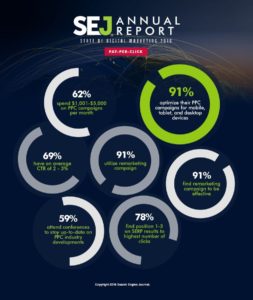Social media has been in the spotlight more than usual lately, and not for positive reasons. Snapchat saw stocks tumble multiple times in recent weeks, while Facebook is taking heat following news that it essentially gave away users’ personal data. This has spawned numerous discussions about social media, including several on this blog. Privacy is at the forefront of people’s concerns, as well as how much we are or aren’t controlled by social media. In the midst of this turmoil, you have to wonder – are people ready for a digital detox and what does that mean for communicators?
In the wake of Facebook’s recent news, some sources have suggested alternatives to Facebook. Twitter is an obvious choice, but there are also a host of up-and-coming platforms, like Path, Raftr, and Vero (Broida, 2018). At the same time, the WhatsApp co-founder tweeted this week that it’s time to delete Facebook, which got the #deletefacebook hashtag trending (Newton, 2018).

Millennials and Generation Z are commonly viewed as the most ubiquitous social media users, always glued to their phones. But even this may be changing. In a recent editorial, one blogger interviewed several teenage girls who decided to put their phones down and take a break from social media (Kourkounis, 2018). Kourkounis (2018) goes on to cite a 2017 poll conducted by a nonprofit that found that over fifty percent of teens have started to step back from their digital lives, particularly social media. Reasons vary, from wanting to avoid drama or hoping to focus on non-digital activities (Kourkounis, 2018).
 Image from http://www.truworthwellness.com/blog/digital-detox-for-improving-your-health.html
Image from http://www.truworthwellness.com/blog/digital-detox-for-improving-your-health.html
Social media is hard to leave. Whether you still use it frequently or not, you likely have a Facebook page, and you probably use Instagram, Twitter, Snapchat, or any of the other social media networks out there. But let’s say people truly do hop on board the #deletefacebook bandwagon, or more teens decide to put their phones down. That disconnect is a detriment to communicators, who thrive on using digital sources to market their brands.
As Statt (2018) notes, Facebook—and all social media, really—is a living, breathing ecosystem. Businesses rely on social media to drive awareness, advertise, and connect with consumers. Facebook is an established mainstay of online marketing (whether Facebook has remained relevant to younger audiences over recent years is another debate). If consumers turn away from Facebook and focus on new platforms, communicators must evolve with the changing marketing landscape. If we ever hit a tipping point and more people put away their phones and detach from being plugged in 24/7, communicators and marketers will need to look ahead to find the next big idea, whatever that may be.
What do you think? Is Facebook in any real danger? Has social media passed its peak? Would you do a social media (or smartphone) detox?
References
Broida, R. (2018, March 22). Social-media alternatives to Facebook [Blog post}. Retrieved from https://www.cnet.com/how-to/social-media-alternatives-to-facebook/
Kourkounis, J. (2018, March 22). On a break: Teens ghost social media [Blog post]. Retrieved from https://whyy.org/segments/on-a-break-teens-ghost-social-media/
Newton, C. (2018, March 20). WhatsApp co-founder tells everyone to delete Facebook [Blog post]. Retrieved from https://www.theverge.com/2018/3/20/17145200/brian-acton-delete-facebook-whatsapp
Statt, N. (2018, March 22). Boycotting digital monopolies like Facebook is harder than it seems [Blog post]. Retrieved from https://www.theverge.com/2018/3/22/17152922/delete-facebook-boycott-cambridge-analytica-tech-monopoly-data-privacy



 Podcasting continues to grow in all ways; number of people that know what a podcast is, amount of time listening, number of podcasts listened to in a week
Podcasting continues to grow in all ways; number of people that know what a podcast is, amount of time listening, number of podcasts listened to in a week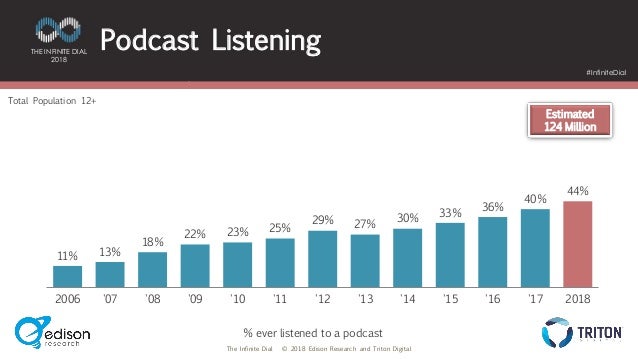
 Smart Speakers are invading households! Up almost triple from last year, this is the fastest growing market ‘round these parts, faster even than the early days of the smartphone. In fact, if you own one Smart Speaker, there’s a 33% chance, you own at least two!
Smart Speakers are invading households! Up almost triple from last year, this is the fastest growing market ‘round these parts, faster even than the early days of the smartphone. In fact, if you own one Smart Speaker, there’s a 33% chance, you own at least two!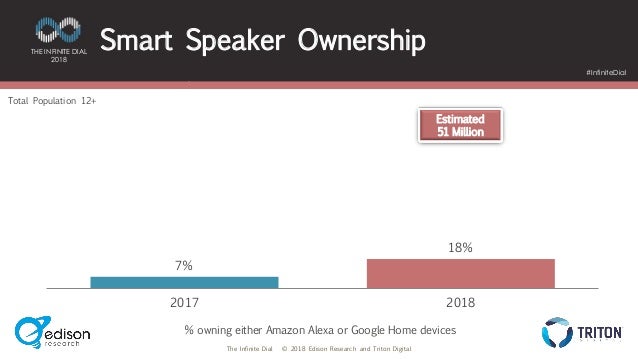
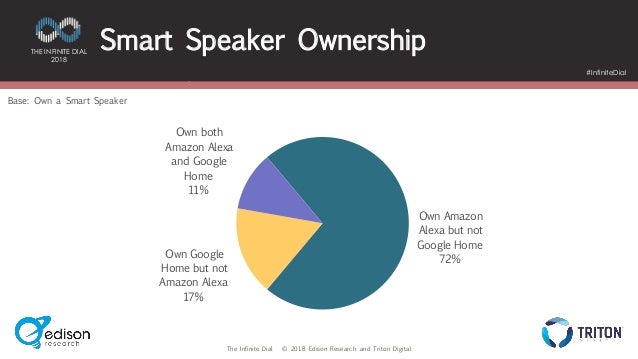
 What’s a r-a-d-i-o? Ya, most Americans don’t know either. Home ownership of radios is down heavily from a decade ago with nearly a third of all Americans tossing them entirely, with that number jumping to HALF if you’re under 35.
What’s a r-a-d-i-o? Ya, most Americans don’t know either. Home ownership of radios is down heavily from a decade ago with nearly a third of all Americans tossing them entirely, with that number jumping to HALF if you’re under 35.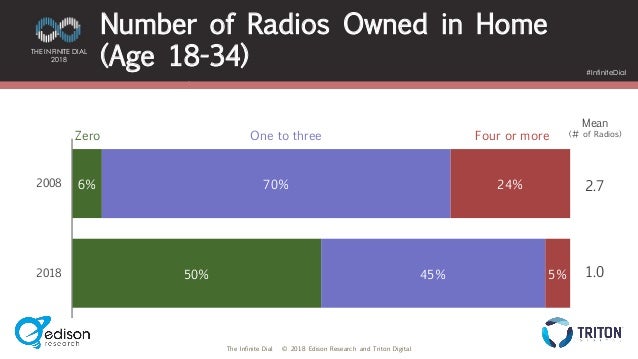

 Pandora is winning…for now. While Pandora remains the market leader, Spotify is on the rise.
Pandora is winning…for now. While Pandora remains the market leader, Spotify is on the rise.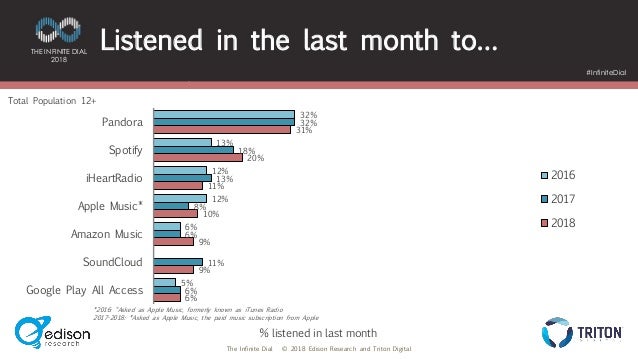
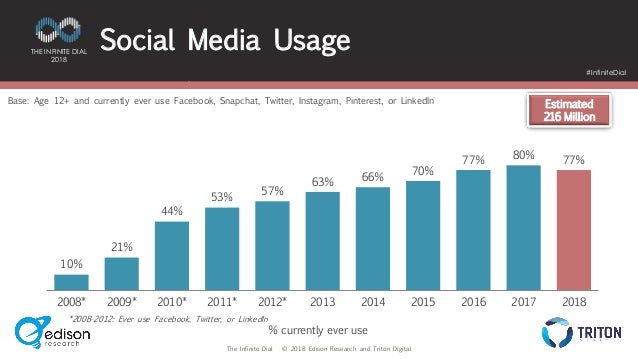
 Facebook is still the most popular, but Snapchat is the fastest growing (this research was done before the
Facebook is still the most popular, but Snapchat is the fastest growing (this research was done before the 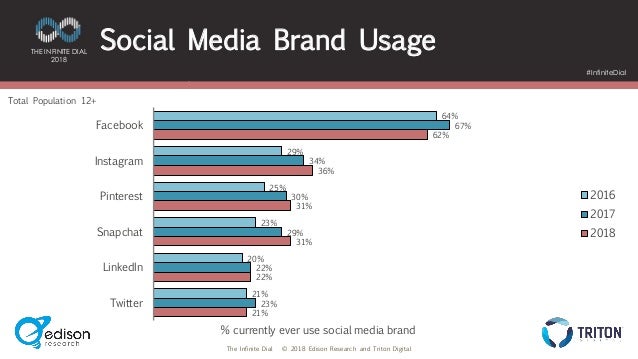
 From a marketing perspective, marketers need to start figuring out podcasting as a channel. This asynchronous, audio-on-demand content is completely available to listeners, with very few revenue streams. All those dedicated ears, intimately tuned in, with nary but the narrator in their ear. So. Much. Opportunity. And with more and more people abandoning social, we’re going to need another channel!
From a marketing perspective, marketers need to start figuring out podcasting as a channel. This asynchronous, audio-on-demand content is completely available to listeners, with very few revenue streams. All those dedicated ears, intimately tuned in, with nary but the narrator in their ear. So. Much. Opportunity. And with more and more people abandoning social, we’re going to need another channel! Additionally, teaching Smart Speakers “skills” is going to be mandatory. While
Additionally, teaching Smart Speakers “skills” is going to be mandatory. While  Finally, social platforms need to figure out their long game. How will SnapChat monetize? How will Facebook keep from hemorrhaging users? How will Instagram stay relevant? Twitter? What’s Twitter? Too, marketers will need to watch the market carefully for key shifts, both for where to invest their budgets, as well as where to find audiences.
Finally, social platforms need to figure out their long game. How will SnapChat monetize? How will Facebook keep from hemorrhaging users? How will Instagram stay relevant? Twitter? What’s Twitter? Too, marketers will need to watch the market carefully for key shifts, both for where to invest their budgets, as well as where to find audiences.



 R Us recently announced plans to liquidate, a move that signals the ultimate demise of a company that once cornered the market on toy sales (Hirsch, 2018). In its prime, Toys R Us was essentially heaven for children of all ages, the preeminent destination for all toys from Lego sets to race cars to video games (Hirsch, 2018). Much of the company’s success was built on the fact it forged strong brand loyalty with a targeted audience—parents who wanted to make their children happy. This strategy worked for most of the 1980s and 1990s, however, a string of ownership changes combined with institutional arrogance led to a fractured relationship between the company and its top demographic (Hirsch, 2018).
R Us recently announced plans to liquidate, a move that signals the ultimate demise of a company that once cornered the market on toy sales (Hirsch, 2018). In its prime, Toys R Us was essentially heaven for children of all ages, the preeminent destination for all toys from Lego sets to race cars to video games (Hirsch, 2018). Much of the company’s success was built on the fact it forged strong brand loyalty with a targeted audience—parents who wanted to make their children happy. This strategy worked for most of the 1980s and 1990s, however, a string of ownership changes combined with institutional arrogance led to a fractured relationship between the company and its top demographic (Hirsch, 2018). with consumer trends, investing in stores that were financially successful, and reallocating resources in those that were not performing as well (Hirsch, 2018). This lack of engagement also manifested itself in the form of actual physical deterioration since Toys R Us ignored opportunities to either renovate its stores or make them look cleaner. Perhaps the company’s most damning mistake is that it never adapted to changing technologies. In the late 1990s, online merchants like Amazon and EToys started popping up in the market and not only threatened Toys R Us’ prime positioning, but supplanted the company as a sales leader. By the time Toys R Us tried to move online, it was already too late and the company had wasted millions of dollars trying to secure exclusive merchandising rights with Amazon.
with consumer trends, investing in stores that were financially successful, and reallocating resources in those that were not performing as well (Hirsch, 2018). This lack of engagement also manifested itself in the form of actual physical deterioration since Toys R Us ignored opportunities to either renovate its stores or make them look cleaner. Perhaps the company’s most damning mistake is that it never adapted to changing technologies. In the late 1990s, online merchants like Amazon and EToys started popping up in the market and not only threatened Toys R Us’ prime positioning, but supplanted the company as a sales leader. By the time Toys R Us tried to move online, it was already too late and the company had wasted millions of dollars trying to secure exclusive merchandising rights with Amazon.





